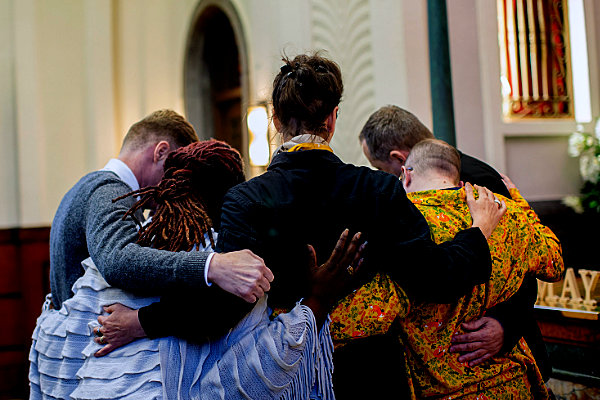by Joanne Kenen
Kaiser Health News
Even when Beltré switched to a hybrid work role — meaning some days in the office, others at home — caring for her father was manageable, though never easy.
For Aida Beltré, working remotely during the pandemic came as a relief.
She was taking care of her father, now 86, who has been in and out of hospitals and rehabs after a worsening series of strokes in recent years.
Working from home for a rental property company, she could handle it. In fact, like most family caregivers during the early days of covid-19, she had to handle it. Community programs for the elderly had shut down.
Even when Beltré switched to a hybrid work role — meaning some days in the office, others at home — caring for her father was manageable, though never easy.
Then she was ordered back to the office full time in 2022. By then, Medicaid was covering 17 hours of home care a week, up from five. But that was not close to enough. Beltré, now 61, was always rushing, always worrying. There was no way she could leave her father alone so long.
She quit. “I needed to see my dad,” she said.

Photo: Pixabay/Mark Thomas
Work-from-home made it much easier for caregivers to take care of their loved ones and improve the quality of life those they were responsible for during the COVID-19 pandemic.
In theory, the national debate about remote or hybrid work is one great big teachable moment about the demands on the 53 million Americans taking care of an elderly or disabled relative.
But the “return to office” debate has centered on commuting, convenience, and child care. That fourth C, caregiving, is seldom mentioned.
That’s a missed opportunity, caregivers and their advocates say.
Employers and co-workers understand the need to take time off to care for a baby. But there’s a lot less understanding about time to care for anyone else. “We need to destigmatize it and create a culture where it’s normalized, like birth or adoption,” said Karen Kavanaugh, chief of strategic initiatives at the Rosalynn Carter Institute for Caregivers. For all the talk of cradle to grave, she said, “mostly, it’s cradle.”
After her stepmother died, Beltré moved her father into her home in Fort Myers, Florida, in 2016. His needs have multiplied, and she’s been juggling, juggling, juggling. She’s exhausted and, now, unemployed.
She’s also not alone. About one-fifth of U.S. workers are family caregivers, and nearly a third have quit a job because of their caregiving responsibilities, according to a report from the Rosalynn Carter Institute. Others cut back their hours. The Rand Corp. has estimated that caregivers lose half a trillion dollars in family income each year — an amount that’s almost certainly gone up since the report was released nearly a decade ago.
Beltré briefly had a remote job but left it. The position required sales pitches to people struggling with elder care, which she found uncomfortable. She rarely gets out — only to the grocery store and church, and even then she’s constantly checking on her dad.
“This is the story of my life,” she said.
Workplace flexibility, however desirable, is no substitute for a national long-term care policy, a viable long-term care insurance market, or paid family leave, none of which are on Washington’s radar.
President Joe Biden gave family caregivers a shoutout in his State of the Union address in February and followed up in April with an executive order aimed at supporting caregivers and incorporating their needs in planning federal programs, including Medicare and Medicaid. Last year, his Department of Health and Human Services released a National Strategy to Support Family Caregivers outlining how federal agencies can help and offering road maps for the private sector.
Although Biden checked off priorities and potential innovations, he didn’t offer any money. That would have to come from Congress. And Congress right now is locked in a battle over cutting spending, not increasing it.
They cashed in his retirement fund to hire part-time caregivers.
So that leaves it up to families.
Remote work can’t fill all the caregiving gaps, particularly when the patient has advanced disease or dementia and needs intense round-the-clock care from a relative who is also trying to do a full-time job from the kitchen table.
But there are countless scenarios in which the option to work remotely is an enormous help.
When a disease flares up. When someone is recuperating from an injury, an operation, or a rough round of chemo. When a paid caregiver is off, or sick, or AWOL. When another family caregiver, the person who usually does the heavy lift literally or metaphorically, needs respite.
“Being able to respond to time-sensitive needs for my dad at the end of his life, and to be present with my stepmother, who was the 24/7 caregiver, was an incredible blessing,” said Gretchen Alkema, a well-known expert in aging policy who now runs a consulting firm and was able to work from her dad’s home as needed.
That flexibility is what Rose Garcia has come to appreciate, as a small-business owner and a caregiver for her husband.
Garcia’s husband and business partner, Alex Sajkovic, has Lou Gehrig’s disease. Because of his escalating needs and the damage the pandemic wrought on their San Francisco stone and porcelain design company, she downsized and redesigned the business. They cashed in his retirement fund to hire part-time caregivers. She goes to work in person sometimes, particularly to meet architects and clients, which she enjoys. The rest of the time she works from home.
As it happened, two of her employees also had caregiving obligations. Her experience, she said, made her open to doing things differently.
For one employee, a hybrid work schedule didn’t work out. She had many demands on her, plus her own serious illness, and couldn’t make her schedule mesh with Garcia’s. For the other staff member, who has a young child and an older mother, hybrid work let her keep the job.
If caregivers quit or go part time, they lose pay, benefits, Social Security, and retirement savings.
A third worker comes in full time, Garcia said. Since he’s often alone, his dogs come too.
In Lincoln, Nebraska, Sarah Rasby was running the yoga studio she co-owned, teaching classes, and taking care of her young children. Then, at 35, her twin sister, Erin Lewis, had a sudden cardiac event that triggered an irreversible and ultimately fatal brain injury. For three heartbreaking years, her sister’s needs were intense, even when she was in a rehab center or nursing home. Rasby, their mother, and other family members spent hour after hour at her side.
Rasby, who also took on all the legal and paperwork tasks for her twin, sold the studio.
“I’m still playing catch-up from all those years of not having income,” said Rasby, now working on a graduate degree in family caregiving.
Economic stress is not unusual. Caregivers are disproportionately women. If caregivers quit or go part time, they lose pay, benefits, Social Security, and retirement savings.
“It’s really important to keep someone attached to the labor market,” the Rosalynn Carter Institute’s Kavanaugh said. Caregivers “prefer to keep working. Their financial security is diminished when they don’t — and they may lose health insurance and other benefits.”
But given the high cost of home care, the sparse insurance coverage for it, and the persistent workforce shortages in home health and adult day programs, caregivers often feel they have no choice but to leave their jobs.
Temote and hybrid work is mostly for people whose jobs are largely computer-based. A restaurant server can’t refill a coffee cup via Zoom.
At the same time, though, more employers, facing a competitive labor market, are realizing that flexibility regarding remote or hybrid work helps attract and retain workers. Big consultant companies like BCG offer advice on “the working caregiver.”
Successful remote work during the pandemic has undercut bosses’ abilities to claim, “You can’t do your job like that,” observed Rita Choula, director of caregiving for the AARP Public Policy Institute. It’s been more common in recent years for employers to offer policies that help workers with child care. Choula wants to see them expanded “so that they represent a broad range of caregiving that occurs across life.”
Yet, even with covid’s reframing of in-person work, telecommuting is still not the norm. A March report from the Bureau of Labor Statistics found only 1 in 4 private businesses had some or all of their workforce remote last summer — a dropoff from 40% in 2021, the second pandemic summer. Only about 1 in 10 workplaces are fully remote.
And remote and hybrid work is mostly for people whose jobs are largely computer-based. A restaurant server can’t refill a coffee cup via Zoom. An assembly line worker can’t weld a car part from her father-in-law’s bedside.
But even in the service and manufacturing sectors, willing employers can explore creative solutions, like modified shift schedules or job shares, said Kavanaugh, who is running pilot programs with businesses in Michigan. Cross-training so workers can fill in for one another when one has to step into caregiving is another strategy.
New approaches can’t come soon enough for Aida Beltré, who finds joy in caregiving along with the burden. She’s looking for work, hybrid this time. “I am a people person,” she said. “I need to get out.”
She also needs to be in. “Every night, he says, ‘Thank you for all you do,’” she said of her father. “I tell him, ‘I do this because I love you.’”
KFF Health News is a national newsroom that produces in-depth journalism about health issues and is one of the core operating programs at KFF—an independent source of health policy research, polling, and journalism. Learn more about
KFF.
 by Terri Dee
by Terri Dee

























